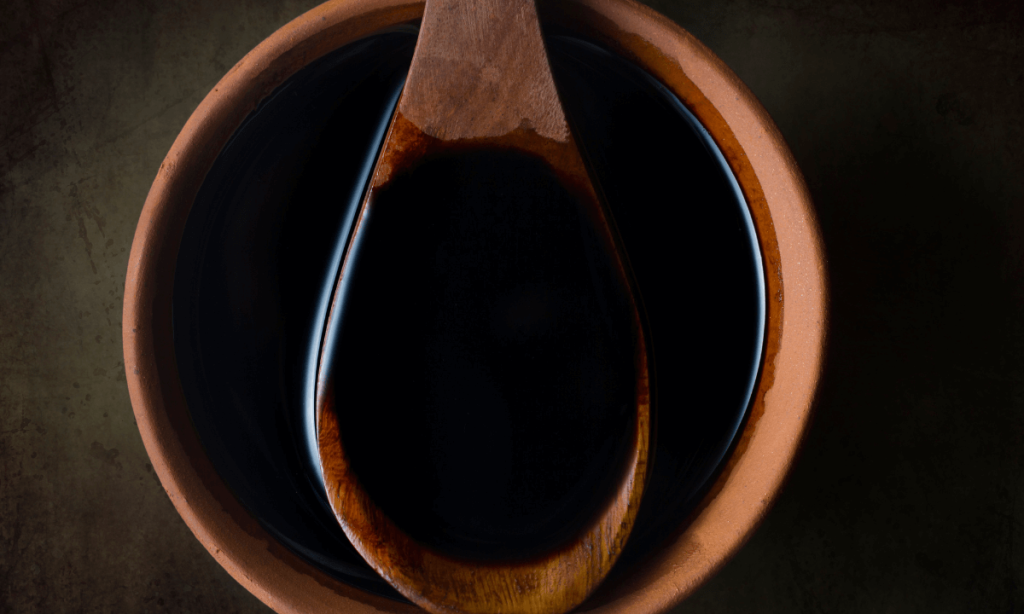What is Dark Soy Sauce?
Dark Soy Sauce, often called a Rich Asian Soy Condiment, has a rich history rooted in ancient China. It’s essential in many Asian dishes, known for its deep, mahogany color and thick consistency. Unlike its lighter counterpart, Dark Soy Sauce is less salty and carries a subtle sweetness.
The brewing of Dark Soy Sauce starts with soybeans and wheat. Makers soak the soybeans, steam them, and mix them with roasted wheat. They then introduce a specific type of mold, usually Aspergillus, to start fermentation. This process, which can last several months, transforms the mix into a thick paste.
Next, they blend this paste with brine and allow it to mature. This maturation varies, lasting from a few months to several years, depending on the desired flavor. The stronger the flavor they want, the longer it matures. To finish, they press the mixture to extract the Dark Soy Sauce. This long process gives it a unique taste, perfect for adding depth and color to dishes.
The Cultural Significance
Dark Soy Sauce holds a special place in Asian culinary traditions. Its roots go deep into the history of Asian cooking, symbolizing more than just a condiment. In countries like China, Japan, and throughout Southeast Asia, Dark Soy Sauce is a heritage ingredient, integral to the identity of many classic dishes.
In Chinese cuisine, it’s a staple for marinating, braising, and adding color to food. It’s key in iconic dishes like red-braised pork and Peking duck. In Japan, it enhances the flavors of sushi and teriyaki. Each region has its own variant, reflecting local tastes and cooking styles.
Beyond flavor, Dark Soy Sauce represents a culinary legacy. Its production methods, passed down through generations, reflect a deep respect for tradition. Families and communities often come together over meals featuring this sauce, celebrating their cultural heritage.
Moreover, it’s a symbol of the Asian philosophy of balance in food – the harmony of flavors. The rich, savory taste of Dark Soy Sauce balances sweet, sour, bitter, and spicy elements, creating dishes that are more than just food; they’re an experience. This deep cultural and culinary significance makes Dark Soy Sauce much more than an ingredient. It’s a vital part of Asia’s rich gastronomic tapestry.
Nutritional Profile and Health Aspects
Dark Soy Sauce, while a key ingredient in Asian cooking for its flavor, also has a notable nutritional profile and health aspects. It’s rich in several essential nutrients, albeit consumed typically in small quantities.
Nutritionally, Dark Soy Sauce contains a modest amount of calories. It’s a good source of micronutrients like manganese, which is essential for bone formation and nutrient absorption. It also provides some iron, necessary for blood health, and magnesium, which supports muscle and nerve function.
One of the most prominent aspects of DSS is its high sodium content. While sodium is crucial for maintaining fluid balance and nerve function, excessive intake can lead to health issues like hypertension. Therefore, it’s advisable to consume DSS in moderation, especially for individuals with salt-sensitive conditions.
Interestingly, Dark Soy Sauce contains antioxidants, thanks to the fermentation process. These antioxidants can help neutralize harmful free radicals in the body, potentially reducing the risk of some chronic diseases.
Moreover, for those concerned about gluten, gluten-free versions of DSS are available, made without wheat. This makes it accessible to those with gluten intolerance or celiac disease.
Health Benefits and Concerns of Dark Soy Sauce
Dark Soy Sauce, a staple in Asian kitchens, offers both health benefits and concerns to consider. Its unique composition contributes to its nutritional and medicinal value, but also raises some dietary considerations.
Health Benefits:
- Rich in Antioxidants: DSS contains antioxidants, which are vital in fighting free radicals in the body. These antioxidants, derived from the fermentation process, can help reduce oxidative stress and may lower the risk of chronic diseases.
- Provides Essential Minerals: Despite its small serving size, DSS offers essential minerals like manganese, important for bone health and metabolism, and iron, crucial for oxygen transport in the blood.
- Aids Digestion: The fermentation process that produces DSS also generates beneficial bacteria. These can contribute to a healthy gut microbiome, aiding in digestion and overall gut health.
Health Concerns:
- High Sodium Content: The most significant concern with DSS is its high sodium content. Excessive sodium intake can lead to health issues like high blood pressure and an increased risk of heart disease. It’s essential for those with hypertension or a heart condition to use it sparingly.
- Allergens and Sensitivities: DSS contains soy and often wheat, which can be problematic for those with allergies or sensitivities. Gluten-free options are available for those with celiac disease or gluten intolerance.
- Additives and Preservatives: Some brands of DSS may contain additives and preservatives, which could have adverse effects on health. It’s advisable to opt for naturally brewed soy sauces with minimal added ingredients.
Cooking with Dark SS: Techniques and Tips
Cooking with DSS is an art that can elevate dishes with its rich, umami-packed flavor. Here are some essential techniques and tips to make the most of this versatile condiment:
- Balancing Flavors: Dark SS has a strong taste, so balance is key. Use it sparingly to avoid overpowering other flavors. It pairs well with sweeteners like sugar or honey and acidic components like vinegar or lime, creating a harmonious flavor profile.
- Marinating: DSS works wonders as a marinade. Its rich color and deep flavor penetrate meats and tofu, giving them a savory, umami-rich taste. Mix it with garlic, ginger, and a touch of sesame oil for an Asian-inspired marinade.
- Enhancing Colors: One of Dark Soy Sauce’s unique qualities is its ability to add a beautiful caramel color to dishes. A splash can transform the appearance of stews, fried rice, and noodles, making them visually appealing.
- Stir-Frying: It’s a go-to sauce for stir-frying. Add it to your wok when cooking vegetables, meats, or tofu to bring a depth of flavor and color. Remember, a little goes a long way!
- Slow Cooking: DSScan be a great addition to slow-cooked dishes. Its flavor intensifies over long cooking periods, adding a complex layer to soups and braises.
- Finishing Touch: Drizzle a little DSS over finished dishes like steamed fish or vegetables as a finishing touch. This not only adds a burst of flavor but also enhances the dish’s visual appeal.
Popular Recipes Featuring Dark Soy Sauce
Dark Soy Sauce is a key ingredient in many iconic recipes, adding a depth of flavor and rich color. Here are a couple of popular recipes where Dark Soy Sauce plays a starring role:
- Classic Beef and Broccoli Stir-Fry: This popular Chinese-American dish showcases the depth DSS brings to simple ingredients. Thinly sliced beef and fresh broccoli florets are stir-fried with garlic, ginger, and a sauce blend of DSS, oyster sauce, and a hint of sugar. The sauce caramelizes beautifully, coating the beef and broccoli in a savory glaze that’s perfect over steamed rice.
- Thai Drunken Noodles (Pad Kee Mao): A staple in Thai cuisine, Drunken Noodles is a fiery and flavorful dish featuring wide rice noodles stir-fried with chicken, bell peppers, Thai basil, and a generous amount of Dark Soy Sauce. The sauce adds a robust, savory element, balancing the heat from the Thai chilies and the sweetness from the Thai basil.
Both these recipes demonstrate the versatility of Dark Soy Sauce, whether it’s in bringing a glossy, umami-rich coating to a stir-fry or adding a deeply savory note to spicy noodles. Its ability to enhance both the flavor and appearance of dishes makes it a beloved ingredient in kitchens around the world.
Different Types of Dark Soy Sauce
DSS is not a one-size-fits-all ingredient. Various regions in Asia have developed their own unique versions, each with distinct characteristics. Understanding these differences can enhance your culinary experiences.
- Chinese DSS: This is perhaps the most commonly known type. It’s thicker, sweeter, and less salty than the light version. It’s often used for adding color and a mild sweetness to dishes. The Chinese variant is essential in recipes like braised pork belly and soy sauce chicken.
- Japanese DSS (Koikuchi Shoyu): Predominant in Japanese cuisine, this soy sauce is a bit lighter and thinner than the Chinese version, but still darker than regular soy sauce. It has a balanced flavor, making it versatile for sushi, marinades, and dipping sauces.
- Indonesian DSS (Kecap Manis): This is a unique variety, significantly sweeter and thicker than its Chinese and Japanese counterparts. It’s almost syrupy and includes added palm sugar and spices, perfect for Indonesian dishes like Nasi Goreng.
- Thai DSS: This version is similar to the Chinese type but slightly sweeter and used primarily for adding color and sweetness to dishes like Pad See Ew.
- Korean DSS (Jin Ganjang): It’s used primarily in marinades and braises, with a profile that’s a bit saltier and less sweet compared to Chinese DSS.
Each type of DSS brings its own flavor profile and consistency, making them suitable for different culinary applications. Whether adding depth to a stir-fry or sweetness to a marinade, these variations offer a world of flavors to explore.
Choosing the Right Sauce
Selecting the right Dark Soy Sauce is crucial for achieving the desired flavor in your dishes. Here are key factors to consider:
- Cuisine Type: Match the sauce to the cuisine you’re cooking. Chinese dark soy sauce is ideal for traditional Chinese dishes, while Indonesian Kecap Manis is better suited for Indonesian recipes.
- Flavor Profile: If you prefer a sweeter, thicker sauce, Indonesian or Thai versions are excellent choices. For a more balanced, less sweet flavor, opt for Chinese or Japanese varieties.
- Ingredients and Quality: Check the label for additives. Pure, naturally brewed soy sauces with fewer additives are generally of higher quality and offer better flavors.
- Brand Reputation: Research brands and seek recommendations. Established brands with good reviews are usually reliable choices.
- Dietary Restrictions: If you have dietary restrictions like gluten intolerance, look for a gluten-free option.
Remember, the right DSS can elevate your dish, so choosing one that aligns with your culinary needs and taste preferences is essential.
Frequently Asked Questions About DDS
- What is the difference between dark and light soy sauce? Dark Soy Sauce is thicker, darker, and slightly sweeter than light soy sauce. It’s used for color and flavor in cooking, whereas light soy sauce is saltier and used primarily for seasoning.
- Can dark soy sauce be substituted for light soy sauce in recipes? It’s not recommended as they serve different purposes. DSS is for color and depth of flavor, while light soy sauce is more for its saltiness and seasoning.
- Is dark soy sauce gluten-free? Traditionally, it contains wheat, so it’s not gluten-free. However, there are gluten-free varieties available made without wheat.
- How should I store dark soy sauce? Keep it in a cool, dry place away from direct sunlight. Refrigeration is recommended after opening to maintain its quality.
- Does dark soy sauce expire? It has a long shelf life but can lose its quality over time. Check the expiration date and look for changes in smell or appearance as indicators.
- Is dark soy sauce vegan? Most traditional dark soy sauces are vegan, as they contain soybeans, wheat, water, and salt. However, always check the label for specific ingredients.
- Can dark soy sauce be used in marinades? Yes, its rich flavor and color make it great for marinades, adding depth to meats and vegetables.
- Is dark soy sauce high in sodium? Yes, it is high in sodium, so it should be used in moderation, especially for those monitoring their salt intake.
- Can I make dark soy sauce at home? While it’s possible, the traditional brewing process is complex and time-consuming, so it’s usually more practical to buy it.
Conclusion
In summary, Dark Soy Sauce is more than just a condiment; it’s a culinary staple with deep cultural roots and a rich history in Asian cuisine. Its unique flavor profile – rich, slightly sweet, and less salty – makes it indispensable in a variety of dishes, from stir-fries to marinades. While choosing the right type of Dark Soy Sauce is crucial for the authenticity of your dishes, it’s also important to be mindful of its high sodium content and the presence of allergens for those with dietary restrictions. Whether you’re a seasoned chef or a home cook, incorporating Dark Soy Sauce into your cooking can add a depth of flavor and color that transforms simple ingredients into extraordinary meals. Its versatility and rich heritage make it a treasured ingredient in kitchens around the world.














